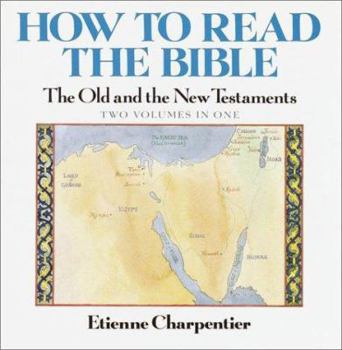How to Read the Bible: The Old and New Testaments (2 Volumes in One)
This indispensable guide to reading the Bible enhances comprehension of both testaments and helps to put events and historical sites within anyone's grasp. This description may be from another edition of this product.
Format:Hardcover
Language:English
ISBN:0517055902
ISBN13:9780517055908
Release Date:April 1993
Publisher:Testament Books
Length:124 Pages
Weight:1.50 lbs.
Dimensions:0.9" x 8.3" x 8.3"
Customer Reviews
2 ratings
A friend for the journey
Published by Thriftbooks.com User , 21 years ago
These volumes in the stellar series by the Crossroad Press on how to read the Bible are available as separate volumes, but the work of Fr. Etienne Charpentier is such that when the reader gets one book, the other book will be desired. These volumes, 'How to Read the Old Testament' and 'How to Read the New Testament' from Charpentier are translated from the French series Les Editions du Cerf. This is in some ways a guide for those who don't know how to read the Bible. It is in some ways done as a travel guide - the Bible is the destination, but like most geographic places, there are actually a variety of landmarks and stops to make in any location, and these will all vary. These books are richly illustrated with maps, line-art drawings, side-bar boxes and pull-boxes, and other graphic-design features that make reading an adventure. One can read through each chapter as a narrative, and then return to fill in the blanks with the sidelined information. The first twenty or so pages of each are a sort of preparation for the journey. The Old Testament volume looks at the basic structure of the Bible (more of a library of books than a 'book' itself). Then, it gives general historical and cultural information to see how the people of the Bible related to and were affected by their geography, their language, their neighbours, etc. There is a basic timeline that the reader can reference as she proceeds through the rest of the text. The New Testament volume looks at three stages of development in the formation of the New Testament: the life and teaching of Jesus, the original communities and their shared stories, then the final redaction and writing of the texts. Then, Charpentier looks both at the literary genre of the Gospels, and the literary genres found in the Gospels. One of Charpentier's very interesting observations is that it is fortunate for us that we do not have a photograph of Jesus - we might even feel, by extension, that we are fortunate to have the ambiguous textual story of him that we do.Following the introduction in the first volume, there are seven chapters roughly following the outline of the history of ancient Israel, and talks about the books of the Bible as they were written, which is not the order in which they are arranged in any of the canons (the Hebrew arrangement and the Christian arrangements are different, but none follow the pattern of original date of authorship as the primary guiding principle). The history begins essentially at the Exodus, as the beginning of the people of Israel as a self-determining group. It proceeds from there to the settlement of Canaan/Palestine, the united kingdom of Saul, David and Solomon, the period of the two kingdoms, the Babylonian exile, the return to partial freedom under Persian domination, and finally existing under Greek and then Roman rule. There is a special chapter on the book of the Psalms, an important book that crosses many boundaries.In the second volume, the chapters
Excellent Introduction to reading the Bible
Published by Thriftbooks.com User , 24 years ago
This is an excellent introduction to "how to read the bible" (aka hermeneutics) for absolute beginners. This particular edition of the book covers both the Old and New Testaments and assumes no previous knowledge yet it is sufficiently detailed for those who want to go beyond the "beginners" stage. There is also a workbook for home study groups.The book is written from a liberal/orthodox catholic Christian perspective and includes a lot of material on the history of the cultures of the various scriptural authors in order to gain cultural context. This book uses both literary criticism and the historical-critical method to illuminate the writings of the bible and would not suit anyone who objects to these approaches.





